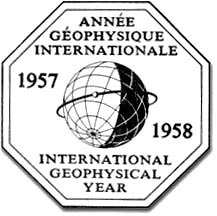International Geophysical Year


The International Geophysical Year (IGY) ( . English : International Geophysical Year (IGY), French. , Offic .: Année de Géophysique International AGI ()) was a - agreed on the basis of international agreement - the period from 1 July 1957 to 31. December 1958. The time was used for worldwide research in all areas of geophysics , including solar research , seismology , glaciology , geomagnetism , meteorology , oceanography , ionosphere , cosmic radiation .
The IGJ was a continuation of the two international polar years 1882/1883 and 1932/1933, but was not limited to the polar regions and therefore required an important organization, of which the Belgian Marcel Nicolet was appointed as general secretary .
At the end of the IGJ, scientists from over 67 countries took part, only the People's Republic of China refused (in protest against the participation of Taiwan ). Both the Soviet Union ( Sputnik ) and the USA ( Vanguard project ) had started programs to bring artificial satellites into earth orbit during the project's lifetime .
history
At the beginning of the 1950s, the idea arose of carrying out another polar year 25 years after the last polar year and about 75 years after the first polar year. The initiative of some American and British scientists resulted in the company being expanded across the globe: geophysical instead of polar. ICSU ( International Science Council ) then gave the green light for this objective . Under the leadership of the International Council of Scientific Unions (ICSU, today: International Council for Science , see: Internationaler Wissenschaftsrat), extensive preparations were started, in the course of which the project was named International Geophysical Year , officially: Année de Géophysique Internationale (AGI ) received.
Improving international cooperation
Because before, as a result of the Cold War , the international exchange of geophysical data was unusually restricted and for some (e.g. meteorological) data was even completely prevented, the IGJ marked a breakthrough in favor of the freedom of science. The decisive factor was that it was only after Josef Stalin's death that the Soviet Academy of Sciences was allowed to participate fully in this global enterprise - which it then did with all its might. The IGJ marked the beginning of an uninterrupted phase of very close geoscientific cooperation in numerous new international projects. The exchange rules of the IGJ were accepted by all major states (with the exception of the People's Republic of China , which did not participate because of Taiwan’s membership ). In order to enable problem-free data exchange, world data centers (WDCs) have been set up for a number of disciplines , most of which have become permanent.
Antarctic Treaty
Last but not least, the IGJ was also an attempt on the part of science to stop the race for national occupation in the Antarctic . It eventually led to the Antarctic Treaty , in which the scientific interest was given priority.
Launch of the first satellites
In the program, the whole globe, but also the adjacent space should be explored, since the advances in rocket technology now made this possible. The US President Dwight D. Eisenhower announced on July 29, 1955 that he would commission an earth satellite as a national contribution from the USA. In times of the Cold War, this was of course a challenge to the Soviet Union, which four days later also announced that it wanted to launch a satellite and which then preceded the USA with Sputnik 1 . The desire for more information about the upper layers of the atmosphere played a major role. The period was chosen so that it would fall into a phase of increased solar activity.
supporter
Existing international scientific unions were involved in the preparation and implementation of the project, particularly the International Astronomical Union (IAU) and the International Union of Radio Science (URSI). The first promoters of the global opening of the project were radio scientists Lloyd Viel Berkner and Dana Bailey, supported by geomagnetic scientist Sydney Chapman . Based on an east-west agreement, the Belgian Marcel Nicolet was appointed General Secretary. After completing the company, King Baudouin I raised him to the nobility.
successes
For some sub-sciences, internationally binding rules for data acquisition were laid down for the first time during the preparation of the IGJ, for example, for ionospheric research, the still valid instructions from William Roy Piggott and Karl Rawer . Only since then have these data become internationally comparable.
With the support of the IGJ, Charles David Keeling, under the direction of Roger Revelle, was able to carry out measurements which, with the Keeling curve , provided evidence for the hitherto hypothetical man-made global warming for the first time . In 1956 Revelle concluded from the results of these measurements that global warming could be expected in around 50 years, with further serious consequences.
anniversary
On the occasion of the 50th anniversary of the International Geophysical Year , an International Heliophysical Year took place in 2007 . 2008 was declared the International Year of Planet Earth .
Trivia
The US musician Donald Fagen dedicated the song IGY to the IGJ on his album The Nightfly from 1982. The IGJ is the namesake of IGY Valley , Antarctica.
literature
- Carl R. Eklund , Joan Beckman: Antarctica - polar research and discovery during the international geophysical year. Holt, Rinehart and Winston, New York 1963
- Walter Sullivan: The international geophysical year. Carnegie Endowment for International Peace, New York, NY 1959
- Sydney Chapman: IGY - Year of discovery: the story of the international geophysical year. University of Michigan Press, Ann Arbor 1959
Web links
- The International Geophysical Year The National Academies ( English )
- Amateur Radio Club Minutes from April 1958
Individual evidence
- ↑ WRPiggott, Karl Rawer: URSI Handbook on ionogram interpretation and Reduction. Elsevier Publ. Comp., Amsterdam 1961. National URSI committees published translations in Chinese, French, Japanese, Russian.
- ^ One big greenhouse time, May 28, 1956

